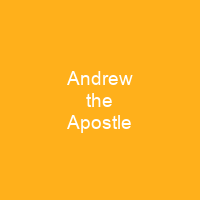Andrew the Apostle, also called Saint Andrew, was an apostle of Jesus according to the New Testament. He is the brother of Saint Peter. Andrew was born between 5 and 10 AD in Bethsaida, in Galilee. According to Orthodox tradition, the apostolic successor to Saint Andrew is the Patriarch of Constantinople.
About Andrew the Apostle in brief

He was buried alongside his brother, Peter, and other apostles of Jesus, including John the Baptist, John the Apostle and John the Zealot. Andrew also knew the boy with the loaves and fishes, and when Philip wanted to tell Jesus about certain Greeks seeking Him, he told Andrew first. In the Gospel of Luke Andrew is not named, nor is reference made to Simon having a brother. The Gospel of John states that Andrew was a disciple of John, whose testimony first led him, and another unnamed disciple, to follow Jesus. In this narrative, Jesus initially used a boat, solely described as being Simon’s, as a platform for preaching to the multitudes on the shore and then as a means to achieving a huge trawl of fish on a night which had hitherto proved fruitless. The narrative indicates that Simon was not the only fisherman in the boat ) but it is not until the next chapter that Andrew is named as Simon’s brother. However, it is generally understood thatAndrew was fishing with Simon on the night in question. Andrew was one of the four disciples who came to Jesus on the Mount of Olives to ask about the signs of Jesus’ return at the “end of the age’”. Eusebius in his Church History 3. 1 quoted Origen as saying that Andrew preach in Scythia.
You want to know more about Andrew the Apostle?
This page is based on the article Andrew the Apostle published in Wikipedia (as of Dec. 10, 2020) and was automatically summarized using artificial intelligence.







